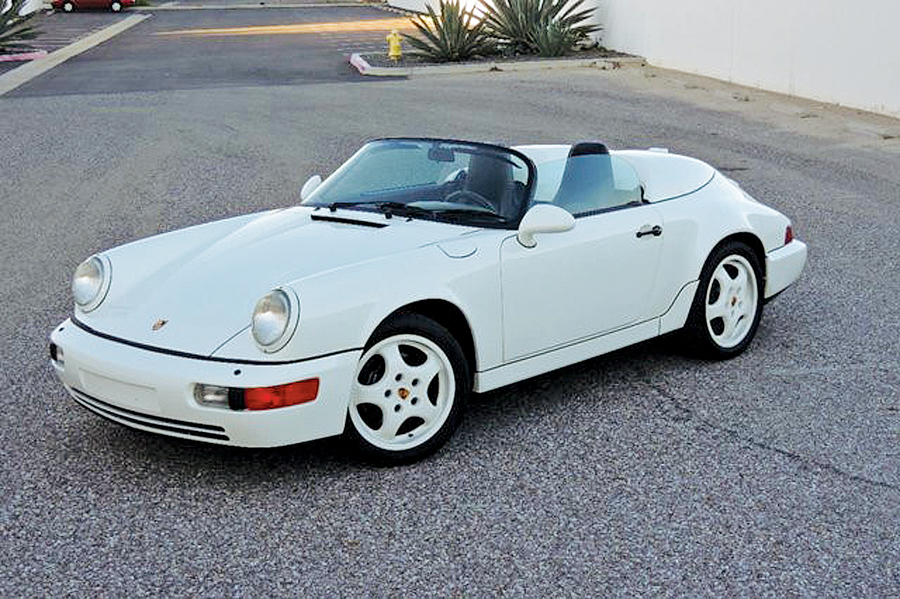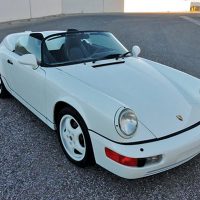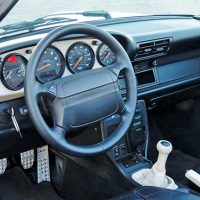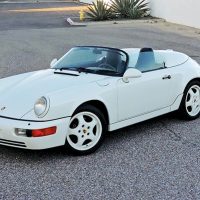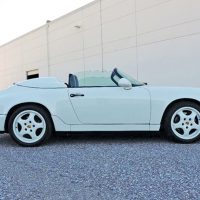- 57,890 miles
- Matching-numbers 3.6L flat 6-cylinder engine
- 5-speed manual transmission
- Rear-wheel drive
- Grand Prix White with Black leather interior
- Velour floor mats
- White wheels with Porsche crests
- Limited-slip differential
- Headlight washers
- AM/FM four-speaker radio with cassette deck and remote CD player
- Sport seat with electric height adjustment
- Air conditioning with climate control
- On-board computer
- Original MSRP and service history dating back to 1995
- Clean CARFAX and Autocheck
SCM Analysis
Detailing
| Vehicle: | 1994 Porsche 911 Speedster |
| Years Produced: | 1994 |
| Number Produced: | 936 |
| Original List Price: | $75,073 |
| SCM Valuation: | $207,500 |
| Tune Up Cost: | $1,500 with plugs and valve adjustment; $5,500–$6,000 for major service, adds wires, rebuilt distributors, coils, plus brakes and gearbox flush |
| Chassis Number Location: | Base of windshield, driver’s side B-pillar, aluminum tag in trunk on passenger’s side inner front fender, paper sticker on bottom side of hood |
| Club Info: | Porsche Club of America |
| Website: | http://www.pca.org |
| Alternatives: | 1995–99 Ferrari F355 Spider, 1986–92 Toyota Supra Turbo, 1994–96 BMW 850CSi |
| Investment Grade: | B |
This car, Lot S90.1, sold for $104,500, including buyer’s premium, at Mecum’s Anaheim, CA, auction on November 19, 2016.
Porsche 964s have proven to be a cautionary tale for Porsche hobbyists who once enjoyed defaming these cars — along with 1974–77 CIS 2.7-liter 911s — as the least desirable models of 911s to buy and own.
The 964s were model years 1990–94 plus 1989 for the advance-release C4s (all-wheel drive). As recently as six to seven years ago, you could buy a decent 964 coupe in either two- or all-wheel drive for under $15,000. For a decade, they were the donors of choice for building almost any Porsche Club race car, street hot rods, and C4-based winter commuter rats.
964 cars on the rise
That all ended a few years back. Today, a good-condition, good-provenance C2 or C4 with 50,000–60,000 miles will fetch $40,000 or more.
What happened?
In part, the 964s followed the increasing values of their successor model, the 993 — and to a lesser extent their predecessor model, the Carrera 3.2 of 1984–89. In fact, the 964 has always been a very capable, easy-to-maintain, long-lived variant of the 911. Its coil-over suspension, which replaced the decades-old torsion bars and trailing arms, power steering, ABS brakes, and strong a/c all contributed. The engine was bulletproof. As those facts came to be more widely appreciated, so did the cars.
Porsche special models in 1992–94
During most of the 964 years, Porsche was financially challenged. Special models with higher price tags helped the money crunch. So the 964 era saw a lot of specials, including:
|
Year/Model |
Number Built |
North America? |
|
1992 Carrera RS 3.6 Basic |
1,910 |
No |
|
Touring |
76 |
No |
|
NGT |
290 |
No |
|
1993 Carrera RS 3.8 (RSR homologation car) |
55 |
No |
|
1992–93 America roadster |
250 |
Yes |
|
1993–94 30-Year Jubilee C4 coupe |
896* |
No |
|
1993–94 RS America |
701** |
Yes |
|
1993 Turbo S Leichtbau |
86 |
No |
|
1994 Turbo S Flachbau (all four variants) |
93*** |
Yes for two |
|
1994 Speedster |
936**** |
Yes |
* 911 examples were scheduled for production, but the run reportedly came up short
** There were 84 1994s with back seats; different VIN ranges for three production runs
*** 10 Japan X83s, 27 Rest of World X84s, 39 North American X85s and 17 slant-delete “package cars”
**** Includes 20 Exclusive Department-built wide-body cars
All of these cars are collectible today, although the America roadster, Jubliee edition and RS America are sometimes viewed as marketing-department specials — albeit with some impactful engineering upgrades. The America roadster was a cabriolet with Turbo body, wheels, suspension and brakes. The Jubi was a wide body with some of the Turbo underpinnings. The RS America was a slightly decontented C2 (minus 77 pounds) with the M030 sports suspension, larger-than-stock wheels, a manual steering rack and fixed whale tail.
Porsche introduced the “stripper” 356 Speedster in ’54
Porsche Speedsters harken back to 1954–58, when Porsche produced the Type 356 Speedster. The original Speedster was a “stripper” model designed to meet a price point in America of $2,995 (tachometer and spare tire/wheel “optional but mandatory”) to help Porsche compete against the less-expensive English offerings from Austin-Healey, Triumph and even MG.
As is well known, the car was developed to the specification of Austrian expat Max Hoffman, who was then Porsche’s United States distributor based in New York City. The Speedster was widely considered to be a warm-climate car — and the base for a capable lightweight race car. The best source (who cataloged the build cards) indicates that Porsche built 4,145 Type 356 Speedsters.
In the Carrera 3.2 era of 1984–89, the Speedster name was resuscitated for a 1989 911 model built 2,103 strong. Those units were predominantly wide-body (aka Turbo-Look) with Turbo suspension and brakes — but fitted with a normally aspirated 247-hp Carrera engine. They also featured a 356-like cut-down windshield and added a contoured fiberglass rear tonneau. Europe got 171 narrow-bodied Carrera 3.2 Speedsters that are prized today because they are rare and different.
The third-generation Speedster on a new platform
The 1994 964 Speedster was a reprise on that 1989 model for the 964 platform, but it was predominantly available in the usual narrow body, without Turbo underpinnings, flares or wide wheels. At the end of the production run, there were 20 wide-bodies built through the Exclusive Department. Of course, they are more prized now.
To close the circle, there was a 2010–11 Type 997 Speedster, built in just 356 examples. Serial number 356 in Pure Blue with almost 1,900 miles will be at auction on Amelia Island in March, estimated at $300,000–$350,000. Watch SCM for how it fares. The 997 Speedsters seem to carry higher prices today than the 1989 or 1994 cars. Of course they were also much more expensive new, and there are far fewer of them.
Does the market prefer 1989s or 1994s?
Porsche aficionados split in preference between the 1989 vs. 1994 Speedsters. Some prefer the muscular wide-body and Turbo suspension and brakes; some prefer the 964 coil-overs, ABS, power steering and updated integrated bumpers. Both models have proven to be collectible, with appreciating values, although the larger production numbers limit them to what our esteemed Publisher and TV show host Keith Martin would call a “B in collectibility.”
Market values tend to be similar for 1989 and 1994 Speedsters. More of the 1994s seem to have been “collected” — stored with minimal mileage. Given similar conditions and mileages, the 1994s are probably the least expensive of all Speedsters.
A very good buy, if you wanted a different “driver”
Our subject 964 Speedster at Mecum’s Anaheim auction was not a collector car because it had high miles — almost 58,000. As a potential fun driver, it looked like a good choice. Grand Prix White is a middle-of-the-market color choice, but it is still eminently acceptable. The car was equipped with sport seats, a/c, limited-slip differential and color-matched wheels. The car had its window sticker, service records back to 1995 — and a clean CARFAX.
This Speedster was a very good buy at $104,500, if it was accident-free and showed no unusual wear, even more so if it had mostly original paint. If you wanted a great-looking, unusual 964 to drive, this Speedster was the ticket. ♦
(Introductory description courtesy of Mecum Auctions.)
